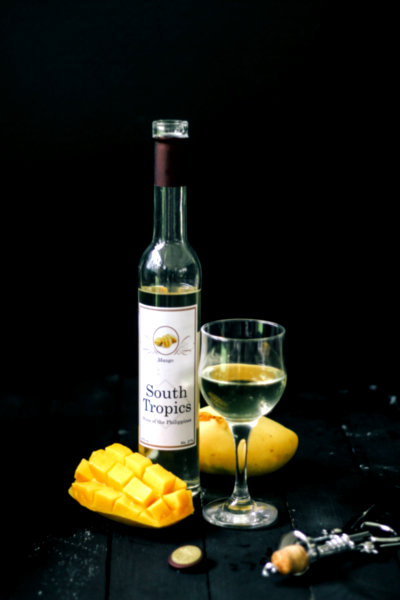Mango (Mangifera indica L.) specifically carabao mango is Philippines’ premier fruit crop. It is the favorite fruit among the Filipinos and popular in other parts of the world. It has smooth yellow skin when ripe and consists of about 60-75% edible portion by weight. It is harvested all year round but peak season is during the months of February to April. Mango is rich in Vitamins A, B and C.

Mango wine has clear golden yellow color, aged in glass vat for at least 6 months. The wine has unique fruity aroma and smooth flavor that provides consumers with a delightful experience.
Mango Wine Processing
Materials:
Mango fruits
Sugar, refined
Wine yeast
Sodium metabisulfite
Cotton
Flasks
Funnel
Gallon jars
Tray/Basin
Strainer
Wire needle
Paddle
Graduated cylinder
Fermentation lock
Wine bottles
Cork/ Aluminum cap
Cap seal
Water bath
Waring blender
pH meter
Hand Refractometer
Procedure:
Starter Preparation
Pasteurize 10% of the total volume of the “must” in boiling water for 30 minutes. Cool to 40-45oC. Inoculate with pure culture of wine yeast. Ferment for 18-24 hours and inoculate in the prepared “must”.
“Must” Preparation
Wash fully ripe fruits (1.0 kg) and drain. Macerate by hand or use a fruit pulper. Add appropriate volume of water (2.0 L) and adjust sugar content to 20oBrix (dry wine) or 25oBrix (sweet wine) by addition of refined sugar.
Treatment of the “Must”
Add 5ml of 10% sodium metabisulfite per gallon of “must” to destroy spoilage microorganisms. Cover the jar properly and stand for 16-18 hours at room temperature.
Fermentation
Add the starter and ferment for 4 days. Filter the “must” to separate the seeds and pulp. Transfer the liquid in clean fermentation jars and cover with fermentation lock. Continue anaerobic fermentation for 3 weeks.
Harvesting, Storing and Aging
Siphon the wine using tygon tubing. Care must be exercised not to make too much movement on the jar so as not to disturb the sediments.
Add 5ml of 10% sodium metabisulfite per gallon of wine. Fill the jars with wine to its brim and cover tightly to prevent access of oxygen.
Store in cool (20oC), dry place for at least 6 months to mature.
Place in clean wine bottles and cover with cork or similar closure. Seal with paraffin- glycerin mixture or plastic seal. Finally, cover the bottle with a cap seal.
This publication is an output of the DA-BAR funded project on “Technology Commercialization and Packaging Development of Wine from Selected Local Fruits” being implemented by the Institute of Food Science and Technology, College of Agriculture, University of the Philippines Los Banos.
For more information, please contact:
Director
Institute of Food Science and Technology
College of Agriculture
University of the Philippines Los Banos
College, Laguna 4031
Telefax No. (049) 536-3472
Tel. No. (049) 536-1070, 536-2312
Prepared by
Erlinda I. Dizon, PhD
Project Leader
Email: [email protected]
Source: trc.gov.ph

Thank you for the information on your website about Mango Wine. My name is Stephen Sallun of Port Moresby city of Papua New Guinea. After two years understand the mango tree that is planted and grow at the backyard of every house in the city and towns of Papua New Guinea. Am keen to tape into small medium business in Port Moresby, Papua New Guinea.
I want to express my interest to start a mango shop product.
Please email information and your mango products including mango wine. I have a small company and would like to go into partnership arrangements.
I can be contacted on:
STEPHEN SALLUN
Upsolut PNG
+ (675) 7686622 or 71117575
E. [email protected]
i need the special requirement for making pure mango wine and if it works for the african mangoes
Basically any mango specie goes. African Mango is perfect. Make sure it’s ripe & sweet BUT not over ripe. Check ripe mangos sugar content. Once they reach the peak, you’ll save a lot instead of adding too much of expensive refined sugar. “Original” sucrose fermentation taste better. What is NOT mentioned here, is the wine yeast. You need to do your own research for suitable wine yeast that works with mango (especially in hot climate countries like Philippines). Yeast may die within days. If you add more yeast, fermentation process will start but you end up mango wine with taste and smell of yeast instead of having clean, tasty mango flavor.